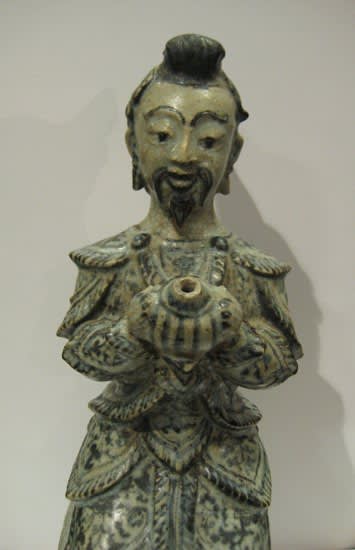Sawankhalok Figure of a Seated Chinese Man, 1500 CE - 1550 CE
Glazed Earthenware
3.1 x 12.1
AM.0135
During the fourteenth and fifteenth centuries, Thailand was a flourishing centre of ceramic production. According to legend, this was sparked off when a Chinese sovereign presented 500 potters as a...
During the fourteenth and fifteenth centuries, Thailand was a flourishing centre of ceramic production. According to legend, this was sparked off when a Chinese sovereign presented 500 potters as a gift to the Sukhothai king, Ram Khamhaeng in the late thirteenth century. Whatever the truth of this story, over the following decades Thai pottery was widely exported to the Philippines, Indonesia and even on occasion to China itself. It has taken a long time for these wares to come to the attention of scholars and the wider public. In fact, even today, their beautiful and inventive creations are only known to a small group of connoisseurs and enthusiasts. This is partly because so few intact examples have been found in Thailand itself- although the kiln sites at Sawankhalok (near the walled city of Sri Sachanalai) have been excavated, most of the finds have consisted of sherds and wasters. It was not until well into the twentieth century that pieces in good condition were discovered in Indonesia and the Philipinnes and recognized as Thai productions. Sunken vessels off the Thai coast have also offered up many fine specimens.
This Sawankhalok seated figure is extremely rare, both in terms of the quality of the workmanship and its excellent condition. Although human figures are quite common within the Sawankhalok corpus, the majority are fairly unrefined maternity figures. Although full of character and vitality, there is no comparison with the detailed finish of this piece. It depicts a seated male, wearing an elaborate costume with ‘petal-shaped’ tiers. He is clearly a figure of some importance, evident from many details including his throne-like seat and pointed shoes. He holds a ceremonial striped vessel between both hands at chest level. The vessel is hollow and there is also a small hole at the back of the head. This suggests that it may have been designed to hold liquid which could be poured out through the front. A delicate floral/foliate scrolling pattern decorates both the fabric of the dress and the three exposed panels of the seat. The man wears a long moustache and a short pointed beard. His hair seems to be rolled up above the forehead and two rectangular lappets are positioned to either side. Most curiously he sports one long plait of hair on his right side. The piece has been carefully worked at the back, suggesting it would have been visible from all angles. The Sawankhalok area was renowned for good sources of clay, which is generally a medium grey in colour. The decoration is painted in black/blue under a transparent glaze. The golden age of Thai ceramic production was relatively short lived. In the sixteenth century, following the Burmese invasions, there is evidence that the kilns were suddenly abandoned. This piece is undoubtedly one of the most splendid surviving examples of Sawankhalok wares.
Reference:
‘The Legacy of Phra Ruang: An Exhibition of Thai Ceramics,’ Bluett and Sons Ltd, (London, 1974)
This Sawankhalok seated figure is extremely rare, both in terms of the quality of the workmanship and its excellent condition. Although human figures are quite common within the Sawankhalok corpus, the majority are fairly unrefined maternity figures. Although full of character and vitality, there is no comparison with the detailed finish of this piece. It depicts a seated male, wearing an elaborate costume with ‘petal-shaped’ tiers. He is clearly a figure of some importance, evident from many details including his throne-like seat and pointed shoes. He holds a ceremonial striped vessel between both hands at chest level. The vessel is hollow and there is also a small hole at the back of the head. This suggests that it may have been designed to hold liquid which could be poured out through the front. A delicate floral/foliate scrolling pattern decorates both the fabric of the dress and the three exposed panels of the seat. The man wears a long moustache and a short pointed beard. His hair seems to be rolled up above the forehead and two rectangular lappets are positioned to either side. Most curiously he sports one long plait of hair on his right side. The piece has been carefully worked at the back, suggesting it would have been visible from all angles. The Sawankhalok area was renowned for good sources of clay, which is generally a medium grey in colour. The decoration is painted in black/blue under a transparent glaze. The golden age of Thai ceramic production was relatively short lived. In the sixteenth century, following the Burmese invasions, there is evidence that the kilns were suddenly abandoned. This piece is undoubtedly one of the most splendid surviving examples of Sawankhalok wares.
Reference:
‘The Legacy of Phra Ruang: An Exhibition of Thai Ceramics,’ Bluett and Sons Ltd, (London, 1974)



